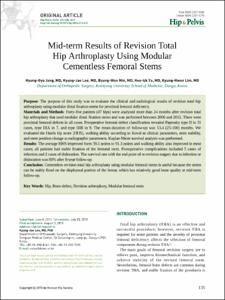KUMEL Repository
1. Journal Papers (연구논문)
1. School of Medicine (의과대학)
Dept. of Orthopedic Surgery (정형외과학)
Mid-term Results of Revision Total Hip Arthroplasty Using Modular Cementless Femoral Stems
- Keimyung Author(s)
- Min, Byung Woo; Lee, Kyung Jae
- Department
- Dept. of Orthopedic Surgery (정형외과학)
- Journal Title
- Hip & Pelvis
- Issued Date
- 2015
- Volume
- 27
- Issue
- 3
- Keyword
- Hip; Bone defect; Revision arthroplasty; Modular femoral stem
- Abstract
- Purpose: The purpose of this study was to evaluate the clinical and radiological results of revision total hip
arthroplasty using modular distal fixation stems for proximal femoral deficiency.
Materials and Methods: Forty-five patients (47 hips) were analyzed more than 24 months after revision total
hip arthroplasty that used modular distal fixation stems and was performed between 2006 and 2012. There were
proximal femoral defects in all cases. Preoperative femoral defect classification revealed Paprosky type II in 31
cases, type IIIA in 7, and type IIIB in 9. The mean duration of follow-up was 53.4 (25-100) months. We
evaluated the Harris hip score (HHS), walking ability according to Koval as clinical parameters, stem stability,
and stem position change as radiographic parameters. Kaplan-Meier survival analysis was performed.
Results: The average HHS improved form 39.5 points to 91.3 points and walking ability also improved in most
cases; all patients had stable fixation of the femoral stem. Postoperative complications included 5 cases of
infection and 2 cases of dislocation. The survival rate with the end point of re-revision surgery due to infection or
dislocation was 86% after 8-year follow-up.
Conclusion: Cementless revision total hip arthroplasty using modular femoral stems is useful because the stems
can be stably fixed on the diaphyseal portion of the femur, which has relatively good bone quality at mid-term
follow-up.
- Publisher
- School of Medicine
- Citation
- Hyung-Gyu Jang et al. (2015). Mid-term Results of Revision Total Hip Arthroplasty Using Modular Cementless Femoral Stems. Hip & Pelvis, 27(3), 135–140. doi: 10.5371/hp.2015.27.3.135
- Type
- Article
- ISSN
- 2287-3260
- Appears in Collections:
- 1. School of Medicine (의과대학) > Dept. of Orthopedic Surgery (정형외과학)
- 파일 목록
-
-
Download
 oak-2015-0152.pdf
기타 데이터 / 548.69 kB / Adobe PDF
oak-2015-0152.pdf
기타 데이터 / 548.69 kB / Adobe PDF
-
Items in Repository are protected by copyright, with all rights reserved, unless otherwise indicated.